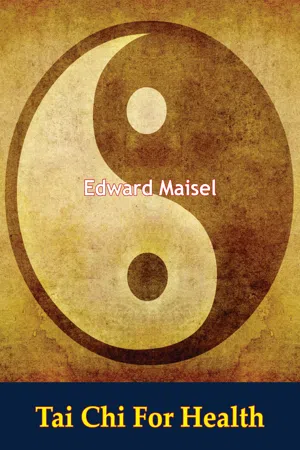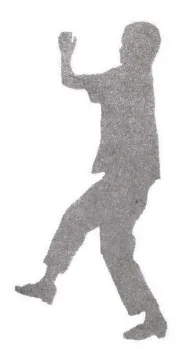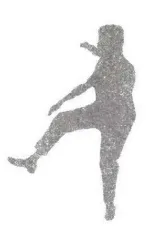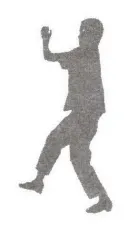
- 128 pages
- English
- ePUB (mobile friendly)
- Available on iOS & Android
eBook - ePub
Tai Chi For Health
About this book
The classic text that introduced Tai Chi to an American audience a generation ago.
Originally published in 1963, it is widely regarded to be the original introduction to the movement art to Western enthusiasts.
"One of the best books on the subject...practical throughout and stripped of mysticism."—The New York Times
"A tranquil, graceful way of keeping fit."—Harper's Bazaar
"You will have to consult Mr. Maisel's book...Tai Chi could become that all-important exercise factor that stands between you and health problems."—Prevention
"It is Chinese, old, comfortable, deeply pleasurable. It helps the figure and skin and tranquilizes. It is done in a small space in ordinary clothes without music. It is good for the young, for the old."—Vogue
Frequently asked questions
Yes, you can cancel anytime from the Subscription tab in your account settings on the Perlego website. Your subscription will stay active until the end of your current billing period. Learn how to cancel your subscription.
At the moment all of our mobile-responsive ePub books are available to download via the app. Most of our PDFs are also available to download and we're working on making the final remaining ones downloadable now. Learn more here.
Perlego offers two plans: Essential and Complete
- Essential is ideal for learners and professionals who enjoy exploring a wide range of subjects. Access the Essential Library with 800,000+ trusted titles and best-sellers across business, personal growth, and the humanities. Includes unlimited reading time and Standard Read Aloud voice.
- Complete: Perfect for advanced learners and researchers needing full, unrestricted access. Unlock 1.4M+ books across hundreds of subjects, including academic and specialized titles. The Complete Plan also includes advanced features like Premium Read Aloud and Research Assistant.
We are an online textbook subscription service, where you can get access to an entire online library for less than the price of a single book per month. With over 1 million books across 1000+ topics, we’ve got you covered! Learn more here.
Look out for the read-aloud symbol on your next book to see if you can listen to it. The read-aloud tool reads text aloud for you, highlighting the text as it is being read. You can pause it, speed it up and slow it down. Learn more here.
Yes! You can use the Perlego app on both iOS or Android devices to read anytime, anywhere — even offline. Perfect for commutes or when you’re on the go.
Please note we cannot support devices running on iOS 13 and Android 7 or earlier. Learn more about using the app.
Please note we cannot support devices running on iOS 13 and Android 7 or earlier. Learn more about using the app.
Yes, you can access Tai Chi For Health by Edward Maisel in PDF and/or ePUB format, as well as other popular books in Medicine & Nutrition, Dietics & Bariatrics. We have over one million books available in our catalogue for you to explore.
Information
Topic
MedicineSubtopic
Nutrition, Dietics & BariatricsPART I—LEARNING ABOUT TAI CHI: The important health benefits it offers you

1—Tai Chi: The What and the Why

The basic, if slightly embarrassing, truth about exercise is plain enough: nobody wants to do the awful stuff. Yet for most of us, calisthenics, that unwanted addition to the unpleasantries of daily existence, has remained the only practical way of keeping fit. “Calisthenics,” as one report to the nation had the candor to admit, “most people won’t touch with a barbell.”
Tai Chi: A Non-strenuous, Pleasant Conditioner
Perhaps, then, for many of us the important news about an ancient Chinese system of exercise which has excited the interest of medical men and physical educators is simply this: it affords a deeply pleasurable experience. Tai Chi Chuan (pronounced Tie Jee Chwahn and usually called Tai Chi for short) has almost nothing in common with the heavy-breathing, exhausting gyrations of our own calisthenics. It is an easy-to-do, non-strenuous, pleasant conditioner.
A growing number of people are adopting Tai Chi as an essential part of their daily program, like food or sleep or cleanliness. To them it has become a regular hygienic practice, no more to be neglected than brushing one’s teeth.
And that, after all, is how exercise must be considered if it is to prove truly beneficial to your physical and general well-being. It is not something to be taken up in spurts, something most often left to the occasional practice of sport on a weekend, holiday or vacation. Rather, the consensus of medical authorities emphasizes that if exercise is to do any real and continuing good, it should be incorporated into everyday life as a natural, unforced activity; it should form a necessary ingredient of your daily routine.
The reason, of course, that this has not generally been the case till now is that what is customarily meant by exercise, or calisthenics, is just too unpleasant, a kind of ordeal in fact, and therefore never to be kept up very long, no matter how firm the initial resolution. In due time, moreover, it also becomes apparent to most people that the supposed benefits to be derived from the usual setting-up exercises, or “daily dozen,” are quite unnoticeable or else far too limited for the effort involved.
People who bother at all with the whole business, therefore, take it up with a kind of grim, virtuous determination at first, and then almost without fail drop it in the end. There are always plenty of convincing reasons they can give themselves, such as having no time, or being in such a perpetual rush that they keep forgetting about it. Nothing much happens after that, unless perhaps after a while there is a new resolve and a next time when the same futile process is repeated.
Tai Chi—a Health Secret from Ancient China
But the exercise known as Tai Chi has been done by the Chinese—the inventors and developers of it—faithfully for hundreds and hundreds of years right up to the present day. And among them it has proved not only its durability but also its worth, many times over, through these centuries of widespread practice. It has been put to the practical test of use. Upon the medical history of Europe and America, as we shall later see, it has also had a considerable effect.
“No way of thinking or doing, however ancient,” a crusty American individualist, Henry David Thoreau, once wrote, “can be trusted without proof.” As Westerners we are bound to hold with Thoreau on this point. Especially perhaps do we have the right to be wary of ancient practices from the East, when we recollect how much nonsense with an Eastern label has got itself accepted by the credulous among us in the name of highbrow esotericism.
Tai Chi’s Benefits Endorsed by Medical Authorities
What is perhaps most to be remarked, therefore, by modern Western students of Tai Chi is the way in which it would seem to accord with both biomechanical and neurophysiological concepts and principles in the light of present knowledge. It jibes with the nature of sensorimotor behavior as we understand it today. Such proof is bound to impress us as much as the evidence of continued use dating from antiquity.
Not surprisingly, then, one specialist in internal medicine, Dr. Charles W. Bien, in formulating his opinion of Tai Chi, has stated, “As a doctor, I consider such exercise as one of the best methods of preventing illness and of promoting good health.” Dr. Bien, who is on the staff of the Kaiser Foundation Hospital at Vallejo, California, perhaps took note of the regularity with which this exercise—because it is so pleasurable—is practiced, when he commended it to all “for better health, greater happiness and more successful living.”
This book takes off from no mumbo-jumbo or cultist platform, but from the pragmatic viewpoint of what is now understood in such fields as anatomy, physiology and psychology. Unless one is interested in doing so, one need not adopt any esoteric doctrines or occult beliefs in order to profit immensely from this tried and true, centuries-old manner of exercise. Anyone who should happen to be thus interested, however, or who merely wishes to take a look at the philosophical background of the long-before, original Taoism—which had later an indirect influence upon the development of Tai Chi—may fortunately find just what he is looking for in a first-rate popular book, The Parting of the Way by Holmes Welch, who expounds this matter in intelligent up-to-date terms.
In point of historic fact, for the greatest number of Chinese themselves, who have practiced it for so many hundreds of years and who still—both in Taiwan and in mainland China—do so today, the exercise is an indispensable adjunct to staying young and in good health, as well as a precious emotional stabilizer. The great majority, that is, have always engaged in it, and do so still, quite without any mystic or religious purpose. It is simply vital hygiene.
About the philosophic tenets of the Taoist movement which gave birth to Tai Chi, therefore, I shall have little enough to say except whatever might practically assist the student in learning the exercise. But it would not be right that my silence in this respect should be construed too complimentarily. For according to Lao-tzu, the nominal founder of Taoism, and referring to the inmost meaning of this philosophy: the man who is silent knows; the man who speaks does not know. The reader impressed by my silence ought at least to consider a third, less flattering possibility unremarked by the great sage-founder: the man who does not speak and who does not know.
The Dangers of Strenuous Physical Activity
Sports and athletics, though a good deal more fun, are, unfortunately for most people, just as unsatisfactory an answer to the question of keeping in good physical condition as the usual forms of calisthenics.
For this there are several reasons. To begin with, except for the professional athlete, our participation in sports and athletic events is too infrequent to sustain us in the continuing fashion required by decent health. Most sports take a sizable amount of time. They cannot very conveniently be pursued through most of the days, weeks, months and years which make up our lives.
The real dangers, moreover, which may be involved in such on-again off-again indulgence in strenuous physical activity are now clearly recognized. When for example a sudden craze for fifty-mile hikes hit the country in 1963, medical authorities at once spoke out against it. “People can endanger themselves,” warned the American Medical Association. “We get distressed when people go out and strain themselves.”
Such wearing hikes, explained Dr. Leonard I. Gordon, a New York heart specialist, might be excellent if one were used to them as a regular thing. “But to take a man off a sedentary job,” Dr. Gordon cautioned, “—to push him out of his swivel chair and on the road—is not.” And a former head of the American Heart Association, Dr. J. Scott Butterworth, acknowledged that walking fifty miles might prove no great problem for Boy Scouts, “but it’s not very sensible,” he urged, “for people who are not used to it.”
On the same score Dr. Janet Travell, President Kennedy’s physician, had already put in a bad word for the supposed American virtue of “efficiency.” It is not only the businessman who sits at a desk the whole week and then plays golf all weekend, according to Dr. Travell, who is asking for trouble. There are also the women who do all their ironing on one day of the week, or who make all their purchases, however heavy the bundles, in a single visit to the supermarket, or who tackle all the household chores, from bathing babies to mopping floors, in one session. There are also the do-it-yourself handymen who spend a sedentary week at the office, and then paint ceilings on Saturdays and Sundays.
To all such paragons of “efficiency,” Dr. Travell’s message was brief: Don’t! At best, muscular aches may lie in store for you; at worst, a weakening of the heart.
It is not only for the average passive citizen that the ill effects, or even possible serious harm, of heavy exertion in sports or other types of activity are now accepted. Important voices are also being raised to question the value of strenuous exercise even for those who do happen to be accustomed to it.
The Effect of Exercise on Life Span
Perhaps the most extensive and systematic research project on the whole topic ever to be conducted in this country was on rats, not men, at the University of Miami Medical School under the direction of Dr. Gordon C. Ring, Chairman of the Department of Physiology. Genetic differences among human beings make it almost impossible to evaluate the important question of what effect exercise may have upon the life span. Dr. Ring and his group, therefore, worked with rats inbred for some eighty generations in order to obtain an answer to this question.
It took them several years, while the subjects were being put through their moderate rodent-style calisthenics, but the results did not show anything significant as to whether moderate activity slows the aging processes. What about the other kind, however? What about strenuous exercise in prolonging useful life? “In fact quite the opposite can be shown to be true for heavy work,” declares Dr. Ring. “The statistics for boilermakers, blacksmiths and the like,” he points out, “clearly show that their life span is less than that of the general population.”
Sports Are Not the Answer
The social context in which we are usually obliged to engage in sports adds to the harm they often do us. In his The Uses of Ineptitude, Nicholas Samstag suggests that “a large fraction of all men engaging in active sports today would obtain a prompt cease-and-desist order (and many of them would receive it with a secret sigh of relief)” if they were to get a complete physical examination and then give their doctors an honest picture of how they were getting their exercise. With engaging candor Samstag himself offers us a typical picture:
“Two rounds of golf a week (one each on Saturday and Sunday) don’t sound like a killing chore until you learn that they are played in an atmosphere of tension in the company of people on whom the player depends for his livelihood, or that they are followed too quickly by too much heavy food and drink or that they’re split rounds, rounds in which the foursome stops after the ninth hole for lunch. It is a wry fact that this pernicious habit usually begins because the player feels that 18 successive holes are too many for him—probably a sound observation. But it is a moot question whether the second nine holes of the new regime aren’t even worse for him, played, as they usually are, with blood pressure and belly distended by too much alcohol, food and competitive exuberance.”
Who is there who could not match the foregoing with a parallel account of the “benefits” too often derived from his own pursuit of fitness through sports, through bowling or riding or billiards perhaps? Who is there who could not do so, that is, if he were able to face the whole subject with such unflinching honesty?
2—How Tai Chi Works Wonders for Your Health

One big shortcoming of most sports is something they have in common with t...
Table of contents
- Title page
- TABLE OF CONTENTS
- DEDICATION
- PART I-LEARNING ABOUT TAI CHI: The important health benefits it offers you
- PART II-THE PRACTICE OF TAI CHI: How To Do It
- PART III-THE STORY OF TAI CHI: How It Can Help You Gain New Benefits from Your Practice
- APPENDIX-THE THREE CLASSIC WRITINGS ON TAI CHI